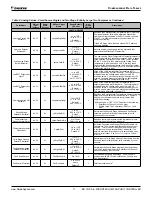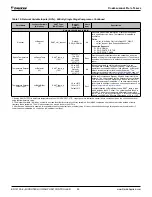
C
omprehensIve
d
aTa
T
ables
www.DaikinApplied.com 11
ED 15103-6 • MICROTECH III WSHP UNIT CONTROLLER
Table 6: Multi-State Values - Enfinity Single Stage Compressor, Continued
Point Name
Object
Type/
Instance
Read/
Write
Access
2
BACnet Object
Name
Range/Default
(in Units)
Non-
volatile
Memory
1
Description
MULTI-STATE VALUES
Previous Alarm
MSV:5
R
PreviousAlarm
1 to 16
N
Indicates the previous unit fault.
1 = No Alarms
2 = Low Voltage Brownout
3 = Comp#1 High Pressure
4 = Comp#2 High Pressure
5 = Comp#1 Low Pressure
6 = Comp#2 Low Pressure
7 = Comp#1 Suctn Temp Snsr Fail
8 = Comp#2 Suctn Temp Snsr Fail
9 = Comp#1 Low Suction Temp
10 = Comp#2 Low Suction Temp
11= Room Temp Sensor Fail
12 = Entering Water Temp Sensor Fail
13 = Condensate Overflow
14 = Serial EEPROM Corrupted
15 = Invalid Configuration
16 = Low Entering Water Temp
Effective Occupancy
Output
MSV:6
R
EffectOccup
1 to 5
N
The Occupancy mode being used by the unit controller.
The mode depends on Occupancy Schedule, Occupancy
Schedule Override, and/or an Occupancy Sensor. MSV6
uses the local sensor unless the MSV7, MSV8, or MSV9
network overrides are not in a Null state. See
1 = Occupied
2 = Unoccupied
3 = Bypass
4 = Standby
5 = Null
Occupancy Override
Input
MSV:7
C
OccManCmd
1 to 5
Default: 5
N
Overrides the Occupancy Schedule. Occupancy Schedule
Override has priority over the Occupancy Schedule and
Remote Occupancy Sensor. It is also where a local timed
override hardwired input is monitored and used to place
the unit in the Occupied mode during the amount of time
declared in Timed Override Setpoint. Schedule Override
and/or an Occupancy Sensor. The network override will
revert back to its default value upon unit controller reboot.
.
1 = Occupied
2 = Unoccupied
3 = Bypass
4 = Standby
5 = Null
Occupancy Scheduler
Input
MSV:8
C
OccSchedule
1 to 4
Default: 4
N
Commands the WSHP into different occupancy modes. A
scheduler or a supervisory controller typically sends the
command using Schedule Override.
7
The network override
will revert back to its default value upon unit controller
reboot. See
1 = Occupied
2 = Unoccupied
3 = Standby
4 = Null
Occupancy Sensor
Input
MSV:9
C
OccSensor
1 to 3
Default: 3
N
Network input used to indicate the presence of occupants
in the space (motion detection.)
7
The network override will
revert back to its default value upon unit controller reboot.
.
1 = Occupied
2 = Unoccupied
3 = Null
Application Mode Input
MSV:10
C
ApplicMode
1 to 7
Default: 7 (Null)
N
Sets the unit in an application mode (Auto, Off, Heat, Cool,
Dehumidification, or Fan Only). Application Mode does not
“force” the unit into any state. However, it does disable
certain unit operations. Examples: 1) Application Mode
of Cool disables heating, 2) Heat disables cooling and
dehumidification, and 3) Fan Only disables heating, cooling,
and dehumidification.
7
PMSV:10 overrides the local room
sensor’s System Mode Switch (Heat/Cool/Auto). The local
System Mode Switch is only used when MSV:10 is set to 7
(Null).
The network override will revert back to its default value
upon unit controller reboot.
1 = Auto
2 = Heat
3 = Cool
4 = Off
5 = Fan Only
6 = Dehumid
7 = Null












































